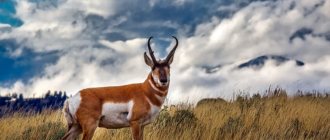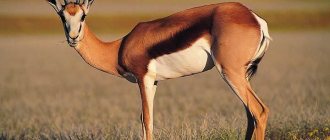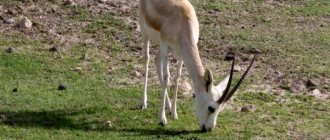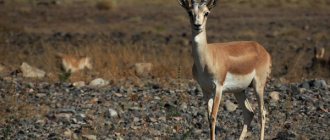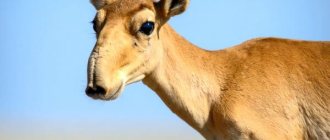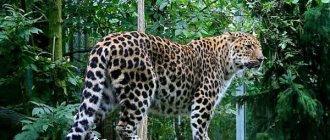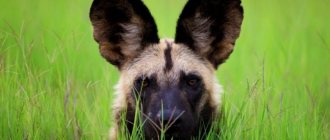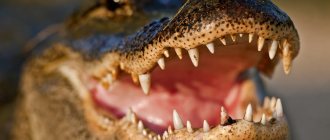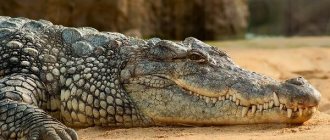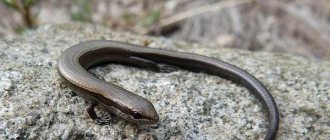The wildebeest is an inhabitant of the African savannah. They are not only quite numerous, but also a very interesting species if you compare their exterior with the appearance of other inhabitants of the savannas. The exterior of these animals is quite unique, since the head and horns are comparable to the head and horns of a bull, and the mane is that of a horse. The body is comparable to that of a cow, the beard resembles that of a mountain goat, and the tail is like that of a donkey. In fact, this animal is a species of antelope. Wildebeest is one of the most famous antelopes living on our Planet.
The locals of the African continent call the wildebeest a “wild animal”, and the word “wildebeest” is nothing more than the sound that these animals make. At least, that’s what those who gave the name to this animal thought.
Appearance
The appearance of these animals is very unusual; it is not for nothing that they are classified as a special subfamily of cow antelopes. At first glance at the wildebeest, it gives the impression of a bull: its large size (height at the withers can reach 140 cm, and weight on average 200-250 kg), massive head with a heavy muzzle and short, steeply curved horns suggest that this is a large cattle. But thin, high legs and a light, swift gallop indicate that this is an antelope.
There are many other absurdities in the appearance of the wildebeest: on the underside of the muzzle and neck it has a thick dewlap of hair like a mountain goat, on the crest of the neck there is a sparse mane like a horse, a thin tail with a tuft of long hair at the end like a donkey, and a voice similar to the abrupt and nasal moo of a cow. It seems as if this antelope was assembled from parts of different animals. The color of the blue wildebeest is dark gray with poorly visible transverse stripes on the body. This species has a subspecies, the white-bearded wildebeest, which has white neck hair. The white-tailed wildebeest is almost black with a white and bushy tail; in appearance, this species is very similar to a horned horse.
Canna
These North African animals are bovine. The artiodactyl is notable for being the largest of the antelopes.
But do not confuse the common eland with the western one. They differ in their horns, the latter having longer ones. Both species are interesting for their jumping ability over long distances (several meters).
Antelope species
The classification of antelopes is not constant and currently includes 7 main subfamilies, which include many interesting varieties:
- Wildebeest or wildebeest (lat. Connochaetes) is an African antelope, a genus of artiodactyl animals of the subfamily of wildebeest, including 2 species: black and blue wildebeest.
- Black wildebeest , also known as white-tailed wildebeest or common wildebeest (lat. Connochaetes gnou) is one of the smallest species of African antelope. The antelope lives in South Africa. The height of males is about 111-121 cm, and the body length reaches 2 meters with a body weight of 160 to 270 kg, and females are slightly inferior in size to males. Antelopes of both sexes are dark brown or black in color, females are lighter than males, and the tails of the animals are always white.
- The blue wildebeest (lat. Connochaetes taurinus) is slightly larger than the black one. The average height of antelopes is 115-145 cm with a weight of 168 to 274 kg. Blue wildebeest get their name from their bluish-gray coat color, and the animals have dark vertical stripes on their sides, like a zebra. The tail and mane of antelopes are black, the horns are cow-type, dark gray or black. Blue wildebeest are distinguished by a very selective diet: antelopes eat certain types of grass, and therefore are forced to migrate to areas where it has rained and the necessary food has grown.
- Nyala or lowland nyala (lat. Tragelaphus angasii) is an African horned antelope from the bovine subfamily and the genus of forest antelopes. The height of the animals is about 110 cm, and the body length reaches 140 cm. Male nyalas are more massive than females. It is very easy to distinguish males from females: gray males wear screw-shaped horns with white tips, ranging from 60 to 83 cm in length, have a bristling mane running along the back, and ragged hair hanging from the front of the neck to the groin. Female nyalas are hornless and have a red-brown color. In individuals of both sexes, up to 18 vertical white stripes are clearly visible on the sides.
- Jungle animals
- Saber-toothed tiger
- 50 facts about kangaroos
- long eared hedgehog
- Cross spider
- Reptiles
- A related species is the mountain nyala (lat. Tragelaphus buxtoni) , which has a more massive body compared to the plain nyala. The body length of the mountain antelope is 150-180 cm, the height at the withers is approximately 1 meter, the horns of males reach 1 m in length. The antelope's weight varies between 150 and 300 kg. The species lives exclusively in the mountainous regions of the Ethiopian Highlands and the East African Rift Valley.
- Horse antelope , also known as roan horse antelope (lat. Hippotragus equinus) is an African saber-horned antelope, one of the largest representatives of the family with a height at the withers of about 1.6 m and a body weight of up to 300 kg. The body length is 227-288 cm. In appearance, the animal resembles a horse. The thick fur of the horse antelope has a grayish-brown color with a red tint, and a black and white mask is “painted” on the face. The heads of individuals of both sexes are decorated with elongated ears with tassels at the tips and well-twisted horns directed in an arched manner backwards.
- Bongo (lat. Tragelaphus eurycerus) is a rare species of African antelope, listed in the International Red Book. These mammals belong to the bovine subfamily and the genus of forest antelopes. Bongos are quite large animals: the height at the withers of mature individuals reaches 1-1.3 m, and the weight is about 200 kg. Representatives of the species are distinguished by a rich, chestnut-red color with white transverse stripes on the sides, islands of white fur on the legs and a white crescent spot on the chest.
- The four-horned antelope (lat. Tetracerus quadricornis) is a rare Asian antelope and the only representative of bovids whose head is decorated with not 2, but 4 horns. The height of these antelopes is about 55-54 cm with a body weight of no more than 22 kg. The animals' body is covered with brown fur, which contrasts with the white belly. Only males are endowed with horns: the front pair of horns barely reaches 4 cm, and most often they are practically invisible, the rear horns grow up to 10 cm in height. The four-horned antelope eats grass and lives in the jungles of India and Nepal.
- Cow antelope , also known as kongoni, steppe bubal or common bubal (lat. Alcelaphus buselaphus) is an African antelope from the subfamily of bubals. Kongoni are large animals with a height of about 1.3 m and a body length of up to 2 m. The cow antelope weighs almost 200 kg. Depending on the subspecies, the Kongoni's coat color varies from light gray to dark brown, with a characteristic black pattern on its face and black markings on its legs. Luxurious horns up to 70 cm long are worn by individuals of both sexes; their shape is a crescent, curved to the sides and upwards.
- The black antelope (lat. Hippotragus niger) is an African antelope that belongs to the genus of equine antelopes, the family of saber-horned antelopes. The height of the black antelope is about 130 cm with a body weight of up to 230 kg. Adult males are distinguished by their blue-black body color, which contrasts favorably with their white belly. Young males and females are brick or dark brown in color. Horns, curved backward in a semicircle and consisting of a large number of rings, are found in individuals of both sexes.
- Eland, also known as common eland (lat. Taurotragus oryx) is the largest antelope in the world. Externally, the eland is similar to a cow, only slimmer, and the dimensions of the animal are impressive: the height at the withers of adult individuals is 1.5 meters, the body length reaches 2-3 meters, and the body weight can be from 500 to 1000 kg. The common eland has a yellow-brown coat that becomes grey-blue on the neck and shoulders as it ages. Males are distinguished by pronounced folds of skin on the neck and a bizarre tuft of hair on the forehead. The distinctive features of the antelope are from 2 to 15 light stripes in the front part of the body, massive shoulders and curled straight horns that adorn both females and males.
- Dwarf antelope , also known as dwarf antelope ( lat. Neotragus pygmaeus) is the smallest of the antelopes and belongs to the subfamily of true antelopes. The height of an adult animal barely reaches 20-23 cm (rarely 30 cm) with a body weight of 1.5 to 3.6 kg. A newborn dwarf antelope weighs about 300 g and can fit in the palm of a person. The hind limbs of the antelope are much longer than the front ones, so in case of alarm the animals are capable of jumping up to 2.5 m in length. The dwarf antelope feeds on leaves and fruits.
- The common gazelle (lat. Gazella gazella) is an animal from the subfamily of true antelopes. The body length of the gazelle varies between 98-115 cm, weight - from 16 to 29.5 kg. Females are lighter than males and inferior to them in size by about 10 cm. The body of the common gazelle is thin, the neck and legs are long, the croup of the mammal is crowned with a tail 8-13 cm long. The horns of males reach 22-29 cm in length, while females have shorter horns - only 6 -12 cm. A distinctive feature of the species is a pair of white stripes on the face that run vertically from the horns through the eyes to the nose of the animal.
- Impala or black-footed antelope (lat. Aepyceros melampus). The body length of representatives of this species varies between 120-160 cm with a height at the withers of 75-95 cm and a weight of 40 to 80 kg. Males wear lyre-shaped horns, the length of which often exceeds 90 cm. The coat color is brown, with the sides being slightly lighter. The belly, chest area, as well as the neck and chin are white. The hind legs have bright black stripes on either side, and there is a tuft of black hair above the hooves. The impala's habitat covers Kenya, Uganda, extending to the savannas of South Africa and the territory of Botswana.
- The saiga or saiga (lat. Saiga tatarica) is an animal from the subfamily of true antelopes. The body length of the saiga ranges from 110 to 146 cm, weight from 23 to 40 kg, height at the withers 60-80 cm. The body has an elongated shape, the limbs are thin and rather short. Only males bear lyre-shaped yellowish-whitish horns. A characteristic feature of the appearance of saigas is the nose: it looks like a movable soft trunk with nostrils as close as possible and gives the animal’s muzzle a certain hunchback.
- The zebra duiker (lat. Cephalophus zebra) is a mammal from the genus of forest duikers. The body length of the duiker is 70-90 cm with a weight of 9 to 20 kg and a height at the withers of 40-50 cm. The body of the animal is squat, with developed muscles and a characteristic curve on the back. The legs are short, with widely spaced hooves. Both sexes have short horns. The coat of the zebra duiker is distinguished by a light orange color; a “zebra” pattern of black stripes is clearly visible on the body - their number varies from 12 to 15 pieces.
- Gazelle (lat. Gazella subgutturosa) is an animal from the genus of gazelles, the bovid family. The body length of the gazelle ranges from 93 to 116 cm, with a weight of 18 to 33 kg and a height at the withers of 60 to 75 cm. The back and sides of the gazelle are sand-colored, the belly, neck and limbs on the inside are white. The tip of the tail is always black. Young animals have a clearly defined pattern on the face: it is represented by a brown spot in the bridge of the nose and a pair of dark stripes running from the eyes to the corners of the mouth.
Gerenuk
An animal from the subfamily of true antelopes, it is very similar to a giraffe, however, it is smaller in size. Small horns are found only on males.
Lives in the deserts of East Africa. Unlike other antelopes, gerenuks do not travel in herds. They can go without drinking for a long time.
Habitat and lifestyle
Wildebeest live in packs on the African continent. They choose the place where there is most grass. If one flock has occupied a certain area of territory, then the other no longer claims it. It is difficult to imagine the diet of antelopes without various types of grasses. The climate of Africa is quite unique, and the weather here varies. In order not to die of hunger, antelopes are forced to change their place of residence several times a year. Antelopes do not live in large flocks; they can be divided into many parts. The wildebeest survives comfortably in small company. Two or three individuals will be enough.
At first glance, antelopes seem to be quite vicious animals, but at the same time they do not pose a danger to other animals. On the contrary, they themselves have many enemies. There are many predators who would love to feast on them. Antelopes are practically powerless against lions and crocodiles. Such animals need a lot of meat to survive. It is quite difficult for the same lion to hunt other animals of the same size, so they hunt down antelopes. As mentioned, they live in small flocks, so there is no one to protect them.
Today there are not many antelope left. The fact that they are the main diet of some animals in their area is not the only reason. Several decades ago, wildebeest hunting was very popular. It was during that period that they almost became extinct at the hands of humans.
Character
The character of the wildebeest is paradoxical. Basically, they look like ordinary peaceful cows, but sometimes they are attacked by incomprehensible attacks, when the animals suddenly begin to kick, jump in one place, or can, in a panic, rush off the bat with the whole herd in one second. And all this happens for no apparent reason. Wildebeest are quick-tempered and often attack smaller herbivores nearby.
Where do they live?
About 5 million years ago, the habitat of antelopes extended to the entire African continent, most of Europe and Asia. Currently, the range has decreased significantly: in addition to Africa, animals are found only in some regions of South Asia.
ZEBRA
Where live
The habitat of antelopes can be very diverse: from densely vegetated forests and mountainous areas to savannas, steppes and semi-deserts.
Nutrition
Wildebeest feed on certain types of grasses. Therefore, in most places, wildebeest herds lead a nomadic lifestyle, migrating twice a year to where there has been rain and there are suitable food plants. Migrating wildebeest, stretching in regular, endless chains from horizon to horizon, or scattered in countless masses across the steppe, are an exciting and unique sight. In naturally demarcated areas, such as in the Ngorongoro Crater, wildebeest do not migrate, but only move regularly during the day from the slopes to the lowlands where watering places lie. Animals rest for a long time near the water, lie on their backs like horses, and play.
Antelope migration
The wildebeest is a very restless creature. But it is not this quality that forces them to migrate, but the rainfall, behind which the animals move. Antelopes are herbivores and cannot live in areas where there is no rain and where there is little food, so they constantly move to new pastures. In July they move from the Serengeti reserve to other places, and after a while - back.
Along the way, weak and sick animals are eliminated, which either lag behind the herd or fall into the clutches of predators. The migration of wildebeest occurs first from south to north, then in the opposite direction. Its peak passes through the Mara River. Moreover, animals are always transported in the same place. Every year many tourists go to watch the migration of antelopes (and this is a truly grandiose and impressive spectacle). The movement of animals can be observed from above (from balloons) or from specially equipped vehicles designed for such tours.
Links
Wiktionary has an entry for "wildebeest"
- Wildebeest // Encyclopedic Dictionary of Brockhaus and Efron: in 86 volumes (82 volumes and 4 additional). - St. Petersburg, 1890-1907.
- s: MESBE / Wildebeest // Small encyclopedic dictionary of Brockhaus and Efron: in 4 volumes - St. Petersburg, 1907-1909.
| This is a draft article on zoology. You can help the project by adding to it. |
| : Incorrect or missing image | To improve this article it is desirable:
|
Reproduction and offspring
The wildebeest rut begins in April and lasts 3 months, until the end of June. This is the time when males organize mating games and battles for ownership of the harem. It does not come to the point of murder and bloodshed. Male wildebeest limit themselves to butting, kneeling opposite each other. The one who wins gets full ownership of 10-15 females. The one who loses is forced to limit himself to one or two.
This is interesting! The composition of migratory and non-migratory wildebeest herds is interesting. Migrating groups include individuals of both sexes and all ages. And in those herds that lead a sedentary lifestyle, females with cubs up to a year graze separately. And males form their own bachelor groups, leaving them at puberty and trying to gain their own territory.
The gestation period for Wildebeest lasts just over 8 months, and therefore offspring are born only in winter - in January or February, just at the time when the rainy season begins, and there is no shortage of food.
Fresh grass grows by leaps and bounds, as do newborn calves. Already 20-30 minutes after birth, wildebeest cubs stand on their legs, and an hour later they run vigorously.
One antelope usually gives birth to one calf, less often – two. Feeds milk until 8 months of age, although babies begin to nibble grass quite early. The cub is under the mother's care for another 9 months after her milk runs out, and only then begins to live independently. It becomes sexually mature by the age of 4 years.
This is interesting! Of 3 newborn wildebeest calves, only 1 survives to one year. The rest become victims of predators.
Enemies of antelopes
The main enemies of antelopes are hyenas, lions, crocodiles, vultures, leopards and cheetahs. Most animals die during migration. Natural selection occurs. The weaker and sicker lag behind the herd and become easy prey for predators. And when crossing rivers, crocodiles do not even attack immediately, but wait until the herds move to the other side. After which they attack those who lag behind the majority. Many antelopes that are in the front rows are simply trampled while crossing by their brothers pressing behind them. And a lot of animal corpses then remain on the shore. The remains are quickly eaten by vultures and hyenas. But still, antelopes cannot be called defenseless. A tightly packed herd can even repel an attack by lions. The latter also try to attack only weak animals. Sometimes predators try to take the young animals away from the herd.
What do they eat?
Antelopes are herbivores. Dividing the stomach into several sections helps them extract the greatest amount of nutrients from plant foods.
The diet includes grass, young shoots and leaves of bushes or trees. Some antelopes eat berries and seeds of various plants, as well as mosses and lichens.
Animals that are unpretentious in food remain in the same territories, changing their diet depending on the season. Species that are selective in food can undertake long seasonal migrations in search of certain plants.
Antelopes get most of their fluid from food, so they can go without water for a long time.
LAMA
Population and species status
In the 19th century, wildebeest was actively hunted by both the local population and the Boer colonizers, who fed their workers with the meat of these animals. Mass destruction continued for more than a hundred years. They came to their senses only in 1870, when there were no more than 600 Wildebeest alive in all of Africa.
The second wave of Boer colonizers was concerned with saving endangered antelope species. They created safe territories for the remnants of the surviving wildebeest herds. Gradually, the number of blue antelopes was restored, but the white-tailed species today can only be found in nature reserves.
Interesting facts about the antelope
- One interesting feature of the wildebeest is still a mystery to scientists. A group of calmly grazing animals suddenly, without any reason, breaks into a mad dance, making huge jumps and lunges from a standing position, as well as kicking their hind legs. A minute later, the “pandemonium” ends just as suddenly, and the animals continue to peacefully nibble the grass, as if nothing had happened.
- Jumping antelopes (lat. Oreotragus oreotragus) in addition to the main coat have hollow hair loosely connected to the skin, which is typical only for this species of antelope and white-tailed deer.
- In some species of antelope, the long neck and articulated structure of the hip joints allow the animals to stand on their hind legs and, leaning their front legs on a tree trunk, reach tree branches, like giraffes.
- Wildebeests are restless animals. Believing that they have the whole continent at their disposal, they migrate from place to place throughout the year: in May they wander from the plains to the forests, and back in November.
- They drink a lot and love to relax near the water. If there are no predators near the watering hole, Wildebeest are happy to roll in the mud and play, enjoying the coolness.
- Wildebeest have many enemies: lions and wildebeest dogs can catch even an adult animal, and leopards and hyenas hunt cubs. They do this at night, when the antelopes easily panic, since during the day the mother will not let her baby be offended.
- The rut begins in April and continues until mid-summer. During this period, males fight for possession of the harem. Particularly lucky ones can win over 10-12 females, while their competitors are content with two or three.
- In February-March, small calves are born, covered with smooth brown fur. The entire herd is in a hurry to welcome the new family member and the mother has to literally fight off her loving relatives, otherwise they will simply trample the newborn.
